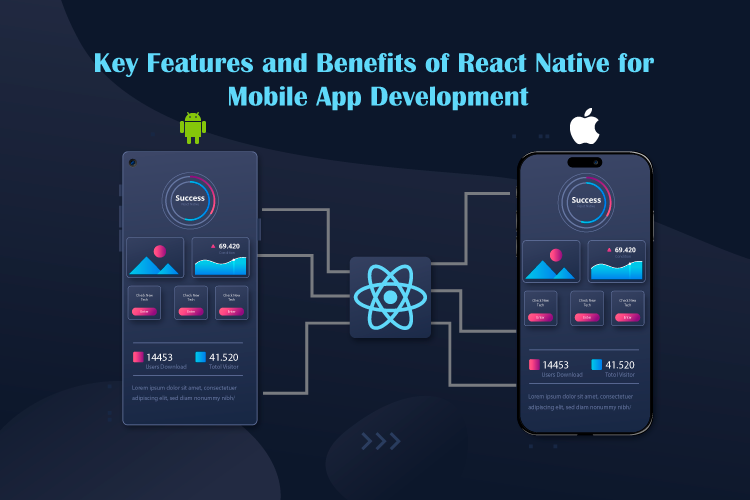By 2024, over 85% of mobile apps will be cross-platform. React Native is leading the charge. In today’s fast-paced world, businesses need to keep up with the demand for high-quality mobile apps across multiple platforms. React Native, developed by Facebook, has emerged as one of the most popular frameworks for building mobile applications. Its ability to deliver high performance, reuse code, and provide a native-like experience makes it a top choice for developers and companies alike. In this blog, we’ll explore the best features and key benefits of using React Native for mobile app development, alongside some of its advanced capabilities.
Best Features of React Native
1. Cross-Platform Compatibility
React Native allows developers to build mobile applications for both iOS and Android using a single codebase. This "write once, run everywhere" approach significantly reduces development time and cost, enabling faster app deployment and easier maintenance. Moreover, React Native extends beyond mobile environments and can be adapted for websites, desktops (macOS, Windows), and smart TVs.
2. Hot Reloading & Fast Refresh
Hot Reloading is one of the most praised features of React Native. It allows developers to instantly view code changes without having to reload the entire app, significantly speeding up development time. The Fast Refresh feature further enhances the developer experience by immediately applying updates during coding sessions, which streamlines bug fixing and feature development.
3. Native Modules Integration
React Native gives access to native modules, making it possible to write custom native code for iOS or Android when necessary. This flexibility allows developers to create apps with complex, device-specific functionalities like camera access, GPS, and sensors, while still benefiting from React Native’s efficiency.
4. Modular Architecture
The modular architecture of React Native enables developers to separate application components into independent blocks, promoting flexibility and scalability. This is especially helpful for larger teams, as different developers can work on various app modules without affecting each other’s work. The modular structure also makes it easier to update and maintain the app.
5. Large Ecosystem of Libraries and Plugins
React Native boasts a vast collection of third-party libraries and plugins that simplify development tasks such as navigation, animations, and API integration. This rich ecosystem saves time and effort by providing pre-built components for commonly required functionalities. Additionally, over-the-air (OTA) updates allow for rapid deployment of bug fixes or small features without needing to go through app store approval processes.
6. Strong Community Support
React Native is supported by a large, active developer community, which makes learning and problem-solving easier. The framework is open-source, so developers continuously contribute to its improvement. With extensive documentation, tutorials, and community forums, even new developers can quickly get up to speed.
Key Benefits of React Native
1. Accelerated Development and Time-to-Market
React Native accelerates app development by allowing code reuse across platforms. This significantly reduces the time it takes to build apps for both iOS and Android, giving businesses the opportunity to launch their apps faster and respond to market demands more swiftly. For instance, building an app in Swift for iOS alone took 33% longer than developing the same app with React Native.
2. Cost-Effectiveness
With React Native, companies can use a single development team to work on both Android and iOS platforms, cutting down on the need for separate teams and reducing costs. This reusability extends to web applications as well, since JavaScript is a shared language across React Native and React, allowing for code sharing and reducing overall expenses.
3. High Performance
React Native apps deliver near-native performance by utilizing native components and optimizing for both platforms. While JavaScript handles the UI and logic, native code is used for performance-intensive tasks, ensuring that apps run smoothly even when dealing with complex animations or data-heavy processes. Performance testing shows that React Native apps are virtually indistinguishable from fully native ones.
4. Seamless User Experience
React Native provides a consistent and responsive user interface across platforms while allowing for platform-specific customizations. This means that users enjoy a seamless experience regardless of whether they’re using an iOS or Android device. Additionally, React Native uses declarative programming, making it easier to detect and fix UI bugs by mapping user paths more clearly.
5. Flexibility and Scalability
React Native’s modular architecture and native integration make it highly flexible, allowing businesses to scale their apps as their needs evolve. Developers can add new features or modify existing ones without compromising the app’s performance. Its support for various platforms, including mobile, web, and smart TVs, ensures that the same business logic can be maintained across devices.
6. Quick Maintenance and Updates
The shared codebase simplifies app maintenance and updates. Changes and bug fixes can be applied to both platforms simultaneously, ensuring consistency across platforms. Over-the-air updates allow developers to quickly push minor changes or fixes without waiting for app store approval, which reduces downtime and improves user satisfaction.
7. Cohesive Development Teams
In traditional native app development, separate teams are required for iOS and Android, which can lead to inconsistencies in the final product. React Native allows a single team to work on the app, ensuring cohesion and a unified development process. Native developers are only required for specific platform-related components, keeping the overall team size smaller and more manageable.
Conclusion
React Native has proven itself as one of the most efficient and cost-effective frameworks for building high-quality mobile applications. Its cross-platform capabilities, fast development cycles, and near-native performance make it the perfect choice for businesses seeking to reduce costs and time-to-market while still delivering a top-tier user experience. With strong community support, a robust ecosystem of libraries, and an ever-evolving feature set, React Native continues to be a key player in mobile app development, catering to both startups and large enterprises alike.
Whether you’re developing your first app or scaling an existing one, React Native offers the flexibility, performance, and efficiency needed to succeed in today’s competitive market.
